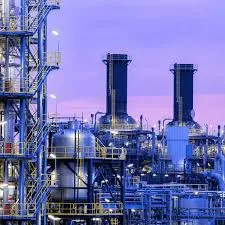Steam Boilers
Steam Boiler Components
The key elements of a boiler system include the feedwater system, burner, combustion chamber, heat exchanger, exhaust stack, and controls. Boiler accessories including the flue gas economizer are also commonly used as an effective method to recover heat from a boiler. These components are related because problems or changes in one generally affect the performance of the others.
Boiler Feed System
A boiler feed system is a large tank that collects the condensate return and fresh makeup water for the system. The tank will have one or several pumps that feed the water to the boiler when the water level drops inside the boiler as sensed by a level control located on the boiler.
Burner
The burner is the key equipment component for combustion control systems, providing the heat required for a boiler to convert water into steam. Ideally, a burner should achieve the highest degree of combustion efficiency with the lowest possible excess air. A burner provides a basic function with a simple concept: it mixes fuel and air together to create combustion. Burners can be fired on various types of fuel but the most common utilized are natural gas, oil, propane and coal. In recent years, facilities have moved away from the use of coal to a more efficient and cleaner fuel like natural gas.
Valves
Saturated steam is used in a brewery at various pressures dependent upon the individual requirements of the different processes. Steam should be generated at the highest possible pressure and then reduced to meet the process requirements.
Accumulator
A steam accumulator is an insulated steel pressure tank containing hot water and steam under pressure that can be released when demand is higher than the capacity of the boiler system. They allow a plant with a low load demand to inject surplus steam into a large amount of water which is under pressure. Over time, the stored water increases in temperature and pressure until it achieves the saturation temperature for the operating pressure of the boiler.
Deaerators
Deaerators are used in applications to reduce corrosion and extend the life of a steam-generating boiler. A deaerator achieves this task by reducing the level of dissolved oxygen and carbon dioxide in the feedwater, which in turn reduces the amount of corrosive compounds within the steam system over time.
Economizer
An economizer is a heat transfer product that will remove heat from the flue gas and add it to the incoming feedwater. Economizers typically are cost effective because they use extended heat transfer surface. Instead of just a bare tube like the boiler, it has a coil attached to the outside of the tube, increasing the surface area and heat transfer surface with only minimal space and tubing increase.
Oil (gas) steam boiler
Control Panel
Boiler controls help produce hot water or steam in a regulated, efficient, and safe manner. Combustion and operating controls regulate the rate of fuel use to meet the demand. The main operating control monitors hot water temperature or steam pressure and sends a signal to control the firing rate, the rate at which fuel and air enters the burner. Common burner firing sequences include on/off, high/low/off and modulating.
Combustion Chamber
The combustion chamber contains the reaction of the fuel with air and uses it to create the heat to produce steam. To enhance the efficiency of the combustion chamber, it needs to be adequately insulated to avoid loss of heat through radiation.
Boiler Level Gauge
Although a boiler level gauge does not control anything, it does tell an operator immediately if the situation is normal or unsafe such that action is required. The American Society of Mechanical Engineers is definitive on the use of level gauges as a direct reading method to determine boiler drum level.
Exhaust Stack
The exhaust stack or flue is the piping that conveys the hot combustion gases away from the boiler to the outside. Typically, this piping is made of steel, but in the case of condensing boilers it needs to be constructed of stainless steel to handle the corrosive condensate.
Blowdown Tank or Cooler
A steam boiler will require regular blow downs to remove undesirable items in the boiler such as solids or oils and to test the low water cutoffs. The International Plumbing Code 701.7 states the boiler blow off temperature must be below 60 degrees C (140°F). By allowing the hot condensate to enter the drain pipes, it could warp or destroy the piping.
























